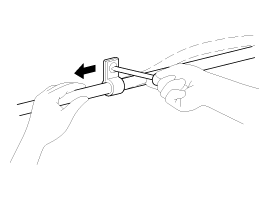 Hyundai Accent: Checking Cables And Wires
Hyundai Accent: Checking Cables And Wires
Hyundai Accent RB (2010-2018) Service Manual / General Information / Checking Cables And Wires
| 1. |
Check the terminal for tightness.
|
| 2. |
Check terminals and wires for corrosion from battery
electrolyte, etc.
|
| 3. |
Check terminals and wires for open circuits.
|
| 4. |
Check wire insulation and coating for damage, cracks
and degrading.
|
| 5. |
Check the conductive parts of terminals for contact
with other metallic parts (vehicle body and other parts).
|
| 6. |
Check grounded parts to verify that there is complete
continuity between their attaching bolt(s) and the vehicle's body.
|
| 7. |
Check for incorrect wiring.
|
| 8. |
Check that the wiring is so clamped to the prevent
contact with sharp corners of the vehicle body, etc. or hot parts (exhaust
manifold, etc.)
|
| 9. |
Check that the wiring is clamped firmly to provide
enough clearance from the fan pulley, fan belt and other rotating or
moving parts.
|
| 10. |
Check that the wiring has a little space so that
it can vibrate between fixed and moving parts such as the vehicle body
and the engine.
|
 Measurement Point
Measurement Point
Measurements should be taken at the center of the hole.
...
 Check Fuses
Check Fuses
A blade type fuse test taps provided to allow checking the
fuse itself without removing if from the fuse box. The fuse is good if the test
lamp lights up when one lead is connected to the tes ...
See also:
Camshaft Position Sensor
(CMPS). Schematic Diagrams
Circuit Diagram
(M/T)
(A/T)
...
Components and Components Location
Component Location
1. -
2. Start relay
3. Cooling fan relay(High)
4. -
5. Main relay
6. Horn relay
7. Air conditioner relay
8. Cooling fan relay(Low)
...
Fuel Pressure Control Valve. Description and Operation
Description
Fuel Pressure Regulator Valve is installed on the high pressure
fuel pump and controls fuel flow flowing into the injectors in accordance with
the ECM signal calculated based on ...
Hyundai Accent Manuals
В© 2011-2026 Copyright www.hamanual.com

